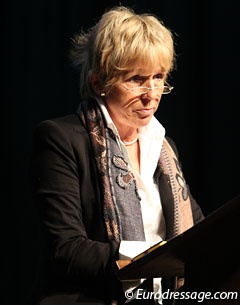
In the regrettable absence of many O- and I-judges as well as the FEI Judge General at the 2011 Global Dressage Forum, Dutch Wim Ernes and German Katrina Wüst stood tall in their presence and willingness to learn from scientific experts and sport colleagues.
On Monday morning they gave a lecture on judging and the FEI judges training and education program. Wüst started by outlining the task of judges as “deciding on the ranking, assessing the performance and providing feedback.” Judges need to have the ability to concentrate for hours and there is a permanent exchange of ideas with colleagues. Judges are responsible to uphold “the rules and principles in dressage”, including “the welfare of the horse.”
The highly disputed “collective marks” which some elite riders like to see removed from the score sheet are a place to provide “advice from the judge,” Wust said. “The top riders say they don’t need them but many others, like juniors and young riders or riders from smaller countries, where there are very few trainers, they appreciated it.”
Wust commented on the different types of biases that judges inherently have to deal with as part of natural human behaviour. In her talk it was amazing to see the progress that has been made in only a few years time concerning the communication with judges. While several years ago criticism as well as scientific expertise were seen as a direct attack on (some) judges in person, now many are opening up to ideas, science and communication amongst colleagues.
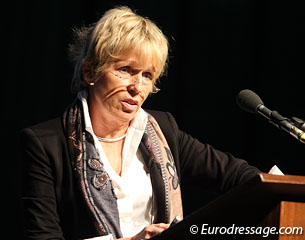 Wust admitted that she realises bias happens at dressage competition, but there are many factors which make it even worse. For instance when talking about ‘order bias,’ which explains that the last riders get higher scores because they are compared to previous rides, Wust said that there are more factors determining the order of go, like the draw based on the FEI Riders’ Ranking as well as show organizers who want to have the best riders grouped together at the end. Scientific evidence, however, shows that this is a bad idea as not each rider will get judged fairly which is why a total random draw is the only way to go in the future.
Wust admitted that she realises bias happens at dressage competition, but there are many factors which make it even worse. For instance when talking about ‘order bias,’ which explains that the last riders get higher scores because they are compared to previous rides, Wust said that there are more factors determining the order of go, like the draw based on the FEI Riders’ Ranking as well as show organizers who want to have the best riders grouped together at the end. Scientific evidence, however, shows that this is a bad idea as not each rider will get judged fairly which is why a total random draw is the only way to go in the future.
Wust acknowledged that trainers put undue pressure on the judges which strengthens conformity bias. “We deal with the pressure of the trainers. The trainers know really well to which judges they can go to complain and from which they better stay away. You have to have a really strong character as a judge,” said Wüst.
The German O-judge also admitted that reputation bias does happen. Top riders get more points based on their name, but she also added that, for instance, with the halt, “they (the top riders) are really good in executing the halt, so easily get an 8 or 9.”
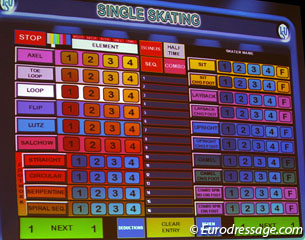 “Good judges are fully aware of all kinds of influence and have learnt to deal with them as competently and fairly as possible,” Wust concluded, adding that good judges are “are not influenced by the running score or the music in the background.”
“Good judges are fully aware of all kinds of influence and have learnt to deal with them as competently and fairly as possible,” Wust concluded, adding that good judges are “are not influenced by the running score or the music in the background.”
According to Wüst the judging system needs no fundamental change. “We have the best judging system ever, but there are still some problems,” she said. The current method of judging is an intrinsic deduction system, in which the judges start from a 10 and deduce from there.
An IDRC member once suggested to use a code of points to have a more rigid point system, but Katrina thinks it impossible. She uses the sport of ice-skating as example, which has a code of points. “With ice-skating there is enough time between the movements, but this system is not applicable for dressage as it goes too fast.”
To Wust the most important problems with judges arise due to geographical spread and personal circumstances. “There is a lack of good national education programmes in some countries. They have a lack of shows, good horses and some judges are far away from top events. Some judges do no have enough riding and judging experience and are unable to cope with the financial requirements and they have language problems. Some of them see it as a status symbol to be an FEI judge.”
Education to Improve Judging
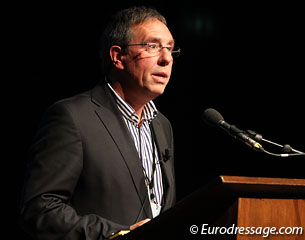 Dutch O-judge Wim Ernes dug deeper into the topic and explained how national judges can become FEI Judges. A clear system has been set up for them to climb the ladder from 2-star level to 5-star level. “Judges have to fulfil clearly defined requirements to stay on the list,” said Ernes.
Dutch O-judge Wim Ernes dug deeper into the topic and explained how national judges can become FEI Judges. A clear system has been set up for them to climb the ladder from 2-star level to 5-star level. “Judges have to fulfil clearly defined requirements to stay on the list,” said Ernes.
Three of the requirements to become an FEI judge are experience at Prix St Georges level, as a rider and as a judge, as well as having a recommendation from one’s national federation.
The 2-star level has been created for judges who want to become an FEI judge in a country where there are no Grand Prix classes. They have to do a qualification course and exam followed by sit-ins and shadow judging before becoming a 3-star judge. The same principles are in place for the other star-levels. “This system is fair, more honest, clear and objective for everybody,” Ernes stressed.
Additions and solutions for the education program in the future are more and smaller refresher seminars, e-learning, a logbook per judge containing the list of shows judged, seminars attended as well as a report by a foreign judge, who assesses the candidate in question at a certain show. The FEI is working on a fast-track for Grand Prix riders to become a judge and David Stickland’s score analyses are applied as educational tool.
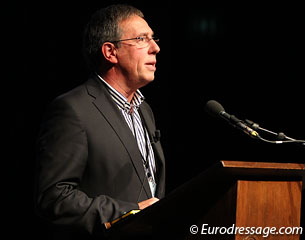 Ernes is also a supporter of creating a professional judges’ corps. “They are paid and sent out to shows all over the world. They are the ears and the mouth of the FEI and give seminars to the regional judges.”
Ernes is also a supporter of creating a professional judges’ corps. “They are paid and sent out to shows all over the world. They are the ears and the mouth of the FEI and give seminars to the regional judges.”
In a role playing game Ernes and Wust demonstrated how shadow judging happens in reality. The candidate judge has to give a score to a movement in a test and explain his rationale behind the score. The mentor judge will discuss and assess the performance with the candidate.
In a panel discussion following the presentation, IDRC secretary-general Wayne Channon praised the speakers for picking up on the issues tackled at the forum last year, but in his opinion, “the biases have to be taken care of, not by you, but by a system. At the top level it is not the training of the judges, but there needs to be a systematic solution.” Channon mentioned that the world top riders are judged fairly, which makes the judging system appear good, but “it should also work for normal horses, on a normal day for normal classes,” which is not always the case at the moment.
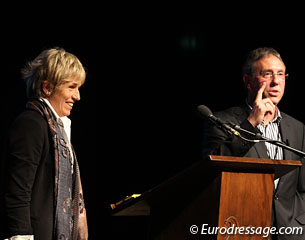 American Grand Prix rider Catherine Haddad questioned the hidden influences or conflicts of interest currently in the sport. To her perceived conflicts of interest affect the sport negatively and have to be removed. “Remove the continuous running score on the board or stop the judges from seeing it as it is a hidden influence,” she stated. She also pleaded for anonimous judging. “Riders can’t know who they got their score from and only the Judging Supervisory Panel can approach the judge if there is a problem.”
American Grand Prix rider Catherine Haddad questioned the hidden influences or conflicts of interest currently in the sport. To her perceived conflicts of interest affect the sport negatively and have to be removed. “Remove the continuous running score on the board or stop the judges from seeing it as it is a hidden influence,” she stated. She also pleaded for anonimous judging. “Riders can’t know who they got their score from and only the Judging Supervisory Panel can approach the judge if there is a problem.”
Ernes responded that he “wants to be held accountable” for his scores and does not prefer an anonimous system.
David Stickland, FEI score analyst, said that, “as a scientist i’m used to accept criticism. What I see rather a lot in this meeting, when science confronts your beliefs, there is a tendency to deny reality. Denial happens, but I much more prefer to see that one assesses the science and reassesses their beliefs.”
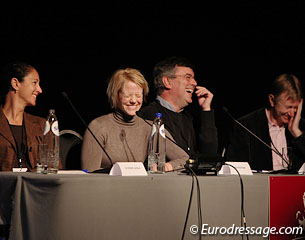 Inga Wolframm, who studied the visual search patterns of judges, had a feeling that one was “still skipping the real issue. Everyone looks at different things at a horse. We need to try and train judges, so they look at the same things. Otherwise we’ll keep having discrepancies between different judges.”
Inga Wolframm, who studied the visual search patterns of judges, had a feeling that one was “still skipping the real issue. Everyone looks at different things at a horse. We need to try and train judges, so they look at the same things. Otherwise we’ll keep having discrepancies between different judges.”
The entire debate on judging, which used to be a walk on eggshells in years past, was now honest and open, which is a major step forwards in the improvement of the judging system.
Next Page of the report: coming soon
Text & Photos © Astrid Appels/Eurodressage.com - No Reproduction Allowed without permission
Eurodressage Coverage of the 2011 Global Dressage Forum